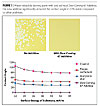Multipurpose Organosilicone Additive for Waterborne Coatings and Inks
Dow Corning® 67 Additive is a multipurpose silicone polyether additive designed specifically for all types of water-based coatings, including wood coatings, UV-cured systems and more.
Advances in waterborne coatings technology in developed countries around the world have been driven by a combination of regulatory restrictions and consumer expectations. Within the past few years, consumers in emerging markets have begun to demand more environmentally friendly products.
Some regulations in the Western world, such as the European Union’s REACH (Registration, Evaluation, Authorization and Restriction of Chemicals) initiative, have affected producers exporting paints and inks. The coatings industry, according to Frost & Sullivan1, also will have a large impact on technology development around the world. Many manufacturers in India, where there is not yet regulation of VOCs in paint, have been proactive in introducing more sustainable technologies in response to growing domestic demand for greener products.
Along with this growing expectation for more environmentally friendly products, consumers expect increasing levels of performance from paint. Waterborne coatings, however, have posed significant challenges to formulators.
Traditional Trade-Offs
The polarity and cohesive hydrogen bonding between water molecules lead to very high surface tension in water-based systems. High surface tension makes it very difficult for paint to properly wet the surface of substrates with uneven and/or porous surfaces. But, proper wetting is necessary for even coating. Poor wetting causes cratering and an increased defect rate. This problem is magnified if dirt particles and other contaminants are present. When paint is applied to very low-surface-energy, materials such as plastics, air entrapment, crawling, framing and poor adhesion often result.
To address these issues, formulators have turned to additives designed to increase substrate wettability and lower surface tension of the coating. In order to achieve complete wetting, coatings must have lower surface tension than the substrate.
Silicone Polyether for Superior Wettability
 Credit: Dow Corning Credit: Dow Corning
|
| Figure 1 Click to enlarge |
Dow Corning’s commitment to sustainability and improving the performance of greener coating formulations led to the development of Dow Corning® 67 Additive, a multipurpose silicone polyether additive designed specifically for all types of water-based coatings, including wood coatings, UV-cured systems and more.
Dow Corning 67 Additive is offered as a water-dispersible, 100%-silicone polyether with recommended use levels of 0.1% to 1%. It has a flash point above 100 ºC (212 ºF) and is stable up to 200 ºC (392 ºF).
This new silicone additive lowers the surface tension of waterborne coating formulations as measured by contact angle. The difference is notable when compared to other commercially available additives (Figure 1). While the new additive significantly enhances wetting properties, it does not have a negative effect on other important properties, such as recoatability.
A distinct advantage of this unique silicone polyether is its ability to wet problem surfaces such as PVC and other plastics without the need to add other solvents. At a 0.2% addition level, with no additional solvent required, Dow Corning 67 Additive clearly outperforms many other types of additives on the market (Figure 2). This feature increases the ability of the formulator to meet strict VOC regulations while providing expected appearance and adhesion properties.

|
| Figure 2 Click to enlarge |
Because it creates a very low dynamic surface tension, the new additive spreads quickly and evenly. The ability to develop water-based systems that perform as well as traditional solventborne inks and coatings under these conditions could provide a significant competitive advantage for formulators.
Ease of use also has been considered when designing this new silicone additive for water-based coatings. Addition is possible at the grind or let down stages of production, or even after all other steps are completed (post-added).
Other Developments
The new silicone additive was developed as part of a comprehensive program aimed at helping customers address such coating property issues as gloss enhancement, slip and mar resistance, impact deadening, UV resistance, touch and feel, heat and temperature resistance, water resistance, and marine foul release capabilities.
Dow Corning’s R&D efforts are focused on the development of novel silicon chemistries, including additives, resins, resin intermediates and other materials, that will enable formulators to produce sustainable coatings solutions for their customers. The company has a strong commitment to the coatings industry around the world and anticipates launching several innovative solutions in the near future.
Additional information on Dow Corning’s additives for inks and coatings is available at www.dowcorning.com/coatings.
Looking for a reprint of this article?
From high-res PDFs to custom plaques, order your copy today!





